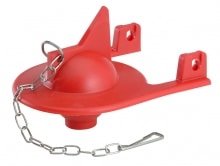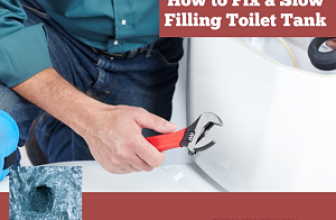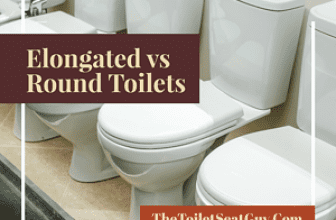
When you look at the anatomy of a toilet, it’s quite easy to overlook the purpose of a flapper. However, the humble toilet flapper plays an integral role in your bathroom.
If installed incorrectly, you might notice leaks, water wastage and an inability to flush your toilet properly.
If you are looking to install a toilet flapper or replace a faulty one, you must know which one to purchase.
The fact that there are different types of toilet flappers in the market, makes it harder for homeowners to choose the correct flapper for their toilets.
Fortunately for you, this article will tell you all you need to know about the different toilet flapper types and any other essential details regarding this important component.
What is a Toilet Flapper and How Does it Work?
A flapper is the toilet part responsible for draining water from the tank to the bowl, when the toilet is flushed. Since toilets differ in models and designs, so do toilet flappers.
Flappers are built to remain sealed when there is water in the toilet tank, until the toilet is flushed. A chain attaches the flapper to the tank lever. This lever, when pressed, pulls the chain and lifts the flapper, resulting in water being released into the bowl.
The flapper also features an air ball that floats when the toilet tank is full. When the tank is empty (fully flushed), the same flapper ball cannot float and is then responsible for sealing the flush valve.
How Does a Toilet Flapper Work?
What Are the Different Types of Toilet Flappers?
There are three main toilet flapper types available: tank ball flappers, seat disk flappers and rubber flappers. Note that each flapper features a different operating mechanism and you need to know the type suitable for your toilet before buying one.
You can do this by opening the lid of your tank and taking note of what the flapper looks like. You can also take a picture and take it with you when shopping for a flapper.
The Three Different Toilet Flapper Types Include:
Tank Ball Flapper
Although not technically a type of toilet flapper, they still perform the same actions as a flapper. Tank balls are more common in older toilets.
The tank ball is attached to a lift wire and when relaxed helps seal the flush valve. When the toilet is flushed the trip wire is pulled upwards, releasing the tank ball from the flush valve. Water will then flow down through the flush valve and into the toilet bowl.
A tank ball flapper will deteriorate over time and lose shape. This means the tank ball will not seal the flush valve enough to prevent water from leaking down into the toilet.
Seat Disk Flapper
Seat Disk Flappers feature a small round disk at the bottom of the tank that covers the overflow pipe. The seat disk prevents water from going through the overflow pipe. However, when flushed, the flapper opens and allows water to flow through.
Seat disk flappers do have some limitations. For instance, they can be quite big and thus take up a lot of space in the tank. Also, they are a little bit more difficult to replace.
Rubber Flapper
Rubber flappers are the most commonly used type of toilet flapper. It works similarly to the tank ball flapper and when you flush the toilet, there is a chain that lifts the flapper, allowing water to flow through the flush valve.
Some of these flappers are made completely of rubber or silicone and are quite flexible, however, some are made of hard plastic but have a rubber or silicone seal on the bottom.
As mentioned earlier, the rubber flapper types are most common because they are reliable and easily available on the market.
Familiarizing yourself with the type of toilet flapper you have can help you choose the right type from the hardware store. Fitting an incompatible toilet flapper might worsen the situation.
Most flappers are made for a specific toilet, so make sure to find the right one.
What Size Toilet Flapper Do I Need?

The best way to know the flapper size you need is by looking at the flush valve draining at the bottom of your toilet tank. Most toilets vary in shape, size and design and also there isn’t a universal flapper size.
Flappers usually come in two-inch or three-inch sizes. In the past, two-inch flappers were more common. But of late three-inch flappers are finding their way into the market.
To know the correct size to pick, you can measure the size of their flush valve systems. You can also do a quick estimation.
An easy comparison guide is: if the flush valve system is the size of a baseball, you will need a 2-inch flapper, however, if it is the size of a softball, you will need a 3-inch flapper.
How Long Does a Toilet Flapper Last?
On average, a toilet flapper can last for around five years. However, if you happen to use strong chemical bowl cleaners, corrosion will occur and regular flapper replacement will be necessary. Therefore, you need to be mindful of the cleaners that you use.
Why Do Toilet Flappers Fail?
Most homeowners never give much thought to the toilet flapper, but this cheap and unassuming part is actually one of the most vital in your bathroom.
Not only does it take prevent leaks in your toilet, it also ensures that you don’t have to flush more than once per visit.
Still, flappers will eventually fail and when they do, it is important to replace them.
Here are Some Reasons Why Flappers Fail:
Age:
The flap and the floating arm are both made of a flexible material, usually rubber or plastic. Over time, this material will crack or simply wear out from repeated use.
It is also important to keep in mind that flappers have been known to develop leaks over as short a time as five years. And while this is not normal, it does happen.
In fact, some manufacturers have specifically indicated that they expect their flappers to last only five years or less. In order to help you determine whether or not it is time to replace your old flapper, simply take a look at its age.
If it has been more than five years since the toilet was first installed, then it may be time to change the flapper.
Mold, Mildew, Bacteria:
Toilet Flappers can malfunction due to mildew, mold or bacteria growth. The growth of these microorganisms can cause the flapper to crack or just not fit tightly around the flush valve anymore.
It is difficult to prevent this issue, so flappers will need to be replaced every five years or so.
Use of Corrosive Chemicals:
Toilet flappers can go bad if excessive corrosive chemicals and tablets have been added to the thank. This is because the chemicals can react with the plastic or rubber material, causing it to break down.
If you suspect this has happened to your toilet, there is a simple way to test to see if it’s the flapper that’s bad or not. Simply pour some colored dye into the tank and let it sit.
If the water in the toilet bowl becomes the color of the dye, then you will know that the flapper is faulty and not sealing the flush valve.
How Do You Know If a Toilet Flapper Needs To Be Replaced?
Just before your toilet flapper becomes useless, it will send you some warning signals. They include:
- Not being able to flush your toilet properly
- Funny noises emanating from the toilet when flushing
- Your toilet running without stopping
- Leaks
Replacing Your Toilet Flapper Too Often?

If your flapper needs to be replaced more often than it should, then there could be a few reasons for this. It could be due to hard water and the use of strong cleaners. Additionally, you could have installed the wrong flapper type/size for your toilet.
Final Thoughts
Toilet flappers play an essential role in your toilet system. Advancements in the toilet manufacturing industry have made flappers more reliable than they were in the past. But for you to benefit from a durable and reliable toilet flapper, you must know which type is ideal for your toilet.
With the above information, you are now ready to head out to your nearest hardware store and pick the toilet flapper type that you need.






